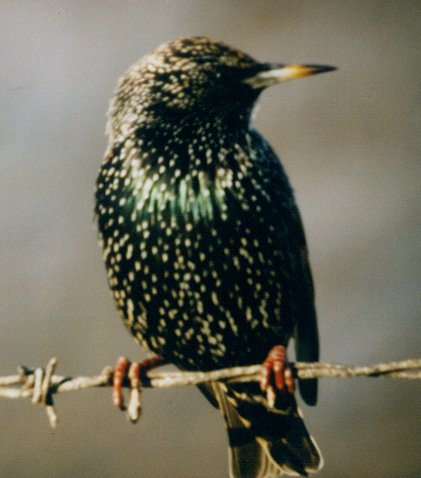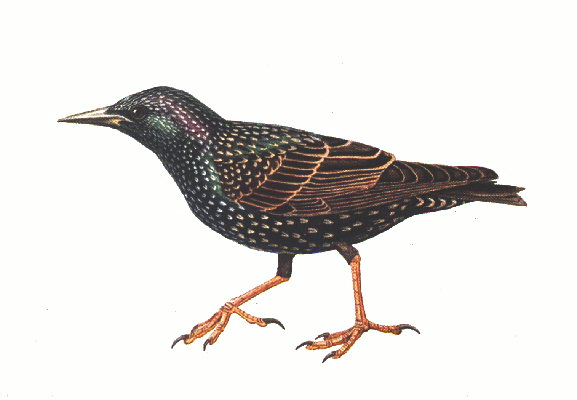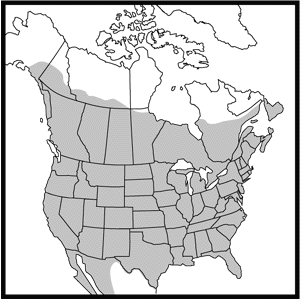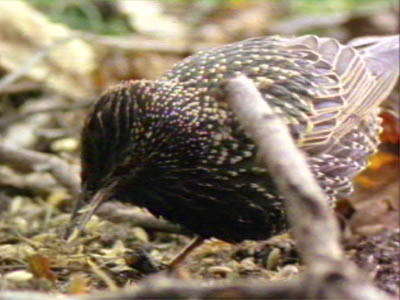
Common Name: European Starling, Common Starling, Purple-winged Starling
Scientific Name: Sturnus vulgaris (Linneaus)
Classification:
Phylum: ChordataIdentification: European starlings are small black birds with an iridescent green and purple gloss on their feathers. The tips of the feathers are cream colored and create a characteristic "flecking" effect. In winter these pale tips erode away exposing the deep purple gloss on the nape, cheeks and throat of the breeding male. During the winter the male also develops elongated breeding plumage on his breast. His back, flanks and rump become a deep iridescent green. By the summer the male's breeding plumage is fully developed. The female lacks the specialized breeding plumage, is generally less colorful, and retains more of the cream colored flecks. Both sexes undergo a complete molt after the breeding season, and return to their winter plumage. During the winter the bill is brown and gradually changes over the year to its summer yellow. A small spot at the base of the bill distinguishes males and females during the breeding season; the male has a steel blue spot, while the female's is a pale pink. Legs of both sexes are a deep pink or reddish color. Juveniles are brown with a paler belly and a brown bill, and undergo a period of variable feather color during the transition from juvenile to adult plumage. Both male and female starlings grow to a length of about 20-22 cm and weigh 70-100 grams. In flight starlings show a short square tail and triangular wings.
Class: Aves
Order: Passeriformes
Family: Sturnidae

Original Distribution: A bird of Eurasia and Northern Africa, the original breeding range of the European Starling extends from northern China to Iceland and the Azores, and south down through Europe to the Mediterranean, Turkey, Iran and Pakistan. Northern and eastern populations migrate, and the winter range includes the Mediterranean, North Africa (north of the Sahara), the Arabian Gulf states, Iran, Iraq and northern India.
Current Distribution:

Range of Sturnus vulgaris
in
North America
A truly global bird, the European Starling has been introduced and become established in New Zealand, Australia, South Africa, and North America. It has also spread to Fiji, Jamaica and Puerto Rico. There are reports of European Starlings breeding in Argentina and occurring in Antarctic islands and Papua New Guinea. In North America the European Starling is found from the Atlantic to the Pacific (east to west) and from central Canada to northern Mexico (north to south). Interestingly, European starlings are declining in parts of their original range (e.g. Britain), possibly due to intensification of large scale commercial agriculture.
Site and Date of Introduction: European Starlings were first introduced to the United States in 1890. Rumor has it that one hundred starlings were released in Central Park in hopes that all of the birds mentioned in Shakespeare's works would become established in the New World. In the case of the starling, the wish became reality. In the intervening hundred years the starling population has grown to an estimated 150-200 million birds.
Mode(s) of Introduction: European Starlings have been intentionally introduced all over the world, generally for aesthetic purposes. Ironically starlings are now widely regarded as pests for various reasons, including the fact that their huge flocks, noisy habits and prodigious waste are considered aesthetically displeasing. In New Zealand some claim that biological control of insect pests was a factor in release, but studies have shown that the starlings are not as effective as was hoped for in this area.

European Starling Foraging
Reason(s)
Why it has Become Established:
European starlings are habitat
generalists, able to exploit a large variety of habitats, nest sites and
food sources. They will eat almost anything, including a diverse
array of invertebrates, fruits, and seeds. In addition, they are
lowland birds that do well in large open areas such as fields and marshes.
These traits, in combination with a long-standing ability to coexist easily
with humans, has enabled them to take advantage of agricultural fields,
livestock facilities, sewage treatment facilities, garbage dumps, cities
and other human related sources of food and nest sites. European
starlings are highly colonial, gathering in huge flocks which may number
in the thousands, to feed and roost. They are aggressive and gregarious
and easily compete with native birds for resources. They are also
abundant and widespread in their native habitats. Their migratory
habits allow them to take advantage of resources that vary by season and
region such as harvests or insect swarms. European starlings are
also flexible - in western France migrating populations have changed their
wintering areas to take advantage of year round food supplies from livestock
facilities. Many birds related to starlings show similar traits;
Common Hill Mynas (Gracula religiosa), Common Mynas (Acridotheres
tristis) and Crested Mynas (Acridotheres cristatellus) are three
that have become established in the United States.
Ecological Role: European Starlings have a significant impact on their environment because they congregate in such large numbers. They probably play a role in seed dispersal because of their consumption of a wide variety of fruits. European Starlings also control some insect populations, but since they will eat almost anything they cannot be relied upon to eat only pests. Insects they are known to feed on include the larvae of craneflies (Tipulidae) and moths (Lepidoptera) as well as mayflies (Ephemeroptera), dragonflies and damsel flies (Odonata), grasshoppers (Orthoptera), earwigs (Dermaptera), lacewings (Neuroptera), caddis flies (Trichoptera), flies (Diptera), sawflies, ants, bees and wasps (Hymenoptera) and beetles (Coleoptera). They will also eat small vertebrates such as lizards and frogs, as well as snails (Gastropoda) and earthworms (Annelida). European Starlings have a particular technique of inserting their closed bill into the ground or an object and then prying the bill open, creating a small hole. This allows them to forage efficiently in soil and among roots as well as in feed troughs and on the backs of ungulates where they search for ectoparisites.
Benefit(s): The most commonly repeated benefit of starling populations is their consumption of insect pests that threaten agriculture. This is a widespread theme; Feare (1999) reported being told of 25 million nest boxes being erected in the former Soviet Union to encourage the establishment of European Starlings. In the United States however, the damage starlings do to crops is normally thought to outweigh any potential use they might have as controllers of insect populations. Aesthetic benefits of European Starlings are also debatable. Huge flocks of starlings are considered a nuisance; on the other hand, many consider starlings to be beautiful birds, and the fantastic aerial displays performed by flocks before roosting in the evening can certainly be impressive. One final potential benefit that we in the U.S. seem to have overlooked, is that of European Starlings as a food source. Starlings have been and continue to be harvested for food in the Netherlands, Spain and France; in France tinned starling pate (pate de sansonnet) is available in many stores, including airport duty free shops.
Threat(s): Far from being considered beautiful, delicious or beneficial, European Starlings in the United States are normally decried as loud, obnoxious, destructive birds, who steal grain, ravage crops and crowd out native bird species. Many of the problems created by starlings stem from their abundance. Flocks can number in the thousands, and when a flock of this size settles on a field the damage they do is considerable. Starlings are particularly culpable in their assaults on crops such as grapes, olives, cherries and grains. In new grain fields starlings pull up the young plants and eat the seeds. Starlings also create formidable problems for livestock and poultry facilities, congregating at feed troughs to eat, and contaminating food and water sources in the process. Starlings are also known to enter buildings to roost and build nests, creating sanitation problems.

European Starlings can carry diseases that are transmissible to livestock and to people, including TGE (transmissible gastroenteritis - a disease of swine), blastomycosis, and samonella. One study found that European Starling droppings contained C. jejuni, L. monocytogenes and C. psittaci, all human bacterial pathogens. The study concluded however, that starling droppings were not a significant source of human infection (Gautsch et al. 2000). In the United States, starling droppings provide a growth medium for Histoplasma capsulatum, the fungus that causes histoplasmosis in humans. All of these examples indicate that the spread of disease by starlings to humans and livestock is a potential threat. Spread of disease among wildlife is another facet of this problem. The Common Myna, a relative of the Common Starling, was implicated in the spread of avian malaria in Hawaii.
Sanitation issues involving starlings also extend to the mundane. In cities, large amounts of droppings can make streets dangerously slippery and can be corrosive to cars, buildings, and statues. Finally, European Starlings often forage near airports and have been implicated in air disasters, particularly when planes have collided with entire flocks of birds.
In addition to the problems they create for people, European Starlings also have detrimental effects on native ecosystems, particularly through their tendency to out compete native bird species for food and nest sites. European Starlings are cavity nesters and are known to compete with woodpeckers, Great Crested Flycatchers, Tree Swallows, Eastern Bluebirds and Purple Martins for nests, possibly causing these populations to decline. Studies documenting these effects have produced differing results, depending on the species examined. For example, Vierling (1998) found that Lewis Woodpeckers (Melanerpes lewis) in Colorado were not out competed for nest sites by European Starlings. Two other studies found that European Starlings did usurp significant numbers of nest site cavities from Northern Flickers (Colaptes auratus) and Red Bellied Woodpeckers (Melanerpes carolinus), and that the presence of additional nest boxes near Flicker nest cavities did not alleviate the problems (Ingold 1998 and 1994). If populations of cavity nesters are declining in areas with large numbers of European Starlings, the effects of nest usurpation by starlings should be examined as a possible cause.

Control Level Diagnosis: I would recommend a control level diagnosis of medium priority. Since European Starlings are so wide spread and well established there is little hope of eliminating all of the problems that they cause. Starlings should be controlled in certain situations that warrant it. For example, starlings should be controlled in habitats of certain native birds that they out compete, as well as on the outskirts of their range to ensure that they do not become established in the Neotropics. Starling should also be controlled in situations where they are doing excessive damage to crops or livestock feed.
Control Method: Many control methods have been advocated, including physical exclusion from crops through use of nets, etc., habitat modification (eliminating nest sites and food and water sources), frightening, repellents, poisoning, shooting and trapping. For use in airports and livestock facilities, frightening has had some success, particularly when recorded distress calls are used. Physical exclusion and habitat modification have also been successful. It is important for farmers and livestock managers to perform a cost assessment to make sure that they are not spending more money controlling starlings than the starlings are actually costing them in losses. Poisons used to control starlings include "Starlicide Complete" (0.1% 3-chloro p-toluidine hydrochloride) which is said to be toxic to some other birds but not to mammals. I do not recommend poisoning because of the possible ramifications of releasing this substance into the environment. However, to eliminate large numbers of starlings, (as opposed to just deterring them), poisoning is probably the most effective method. Shooting is more of a glorified scare tactic and trapping does not affect large enough numbers for the time investment (maybe combining trapping with a pate production plant would make this cost effective!). A possible long term solution, particularly for reducing numbers of starlings in areas where they are competing for nest sites with cavity nesters, might be to provide a large number of nest boxes away from the immediate areas of the cavity nesters, and then remove eggs or young. Starlings are known to double clutch so this would have to be regularly monitored. I am not aware that this has been tried, or whether it would be too difficult and time consuming to be worth while.
References:
Chow J.2000. (2 Oct.2001). "Sturnus vulgaris." The University of Michigan Museum of Zoology Animal Diversity Web. http://animaldiversity.ummz.umich.edu/accounts/sturnus/s._vulgaris
Dolbeer, R. A., S. E. Wright, et al. 2000. “Ranking the hazard level of wildlife species to aviation.” Wildlife Society Bulletin 28(2): 372-378.
Feare, C.and Craig A. 1999. "Starlings and Mynas". Princeton University Press, Princeton, NJ.
Gautsch, S., P. Odermatt, et al. 2000. “The role of starlings (Sturnus vulgaris) in the epidemiology of potentially human bacterial pathogens.” Schweizer Archiv Fur Tierheilkunde 142(4): 165-172.
Ingold, D. J. 1994. “Influence of Nest-Site Competition between European Starlings and Woodpeckers.” Wilson Bulletin 106(2): 227-241.
Ingold, D. J. 1998. “The influence of Starlings on Flicker reproduction when both naturally excavated cavities and artificial nest boxes are available.” Wilson Bulletin 110(2): 218-225.
Johnson R. and Glahn J. 1998. (2 Oct.2001). "Starling Management in Agriculture." Nebraska Cooperative Extension, NCR 451. http://ianrwww.unl.edu/pubs/wildlife/ncr451.htm
Sayre, R. W. and L. Clark 2001. “Effect of primary and secondary repellents on European starlings: An initial assessment.” Journal of Wildlife Management 65(3): 461-469.
The Birdhouse Network 2001.(2 Oct.2001). "European Starling." http://birds.cornell.edu/birdhouse/speciesaccounts/EUROSTAR.HTM
Vierling, K. T. 1998. “Interactions
between European starlings and Lewis' Woodpeckers at nest cavities.” Journal
of Field Ornithology 69(3): 376-379.